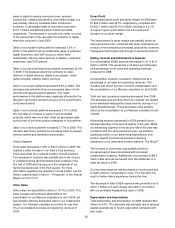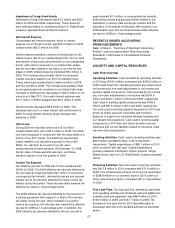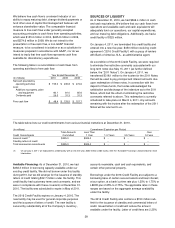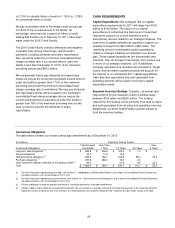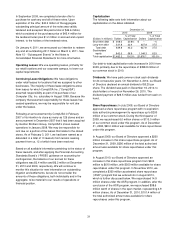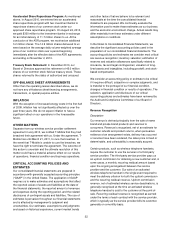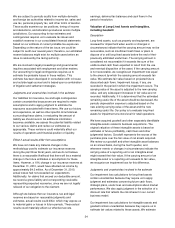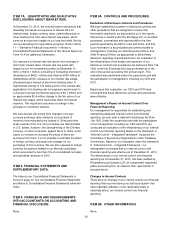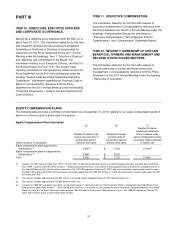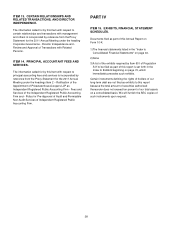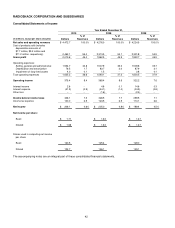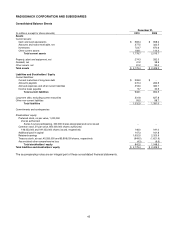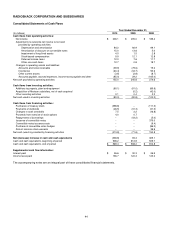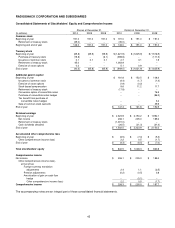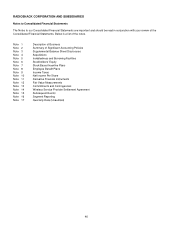Radio Shack 2010 Annual Report Download - page 46
Download and view the complete annual report
Please find page 46 of the 2010 Radio Shack annual report below. You can navigate through the pages in the report by either clicking on the pages listed below, or by using the keyword search tool below to find specific information within the annual report.36
ITEM 7A. QUANTITATIVE AND QUALITATIVE
DISCLOSURES ABOUT MARKET RISK.
At December 31, 2010, the only derivative instruments that
materially increased our exposure to market risks for
interest rates, foreign currency rates, commodity prices or
other market price risks were interest rate swaps, which
serve as an economic hedge on our long-term debt. We do
not use derivatives for speculative purposes. Refer to Note
11 – “Derivative Financial Instruments” in Notes to
Consolidated Financial Statements of this Annual Report on
Form 10-K for additional information.
Our exposure to interest rate risk results from changes in
short-term interest rates. Interest rate risk exists with
respect to our net investment position at December 31,
2010, of $312.1 million, consisting of fluctuating short-term
investments of $462.1 million and offset by $150 million of
indebtedness which, because of our interest rate swaps,
effectively bears interest at short-term floating rates. A
hypothetical change of 100 basis points in the interest rate
applicable to this floating-rate net exposure would result in
a change in annual net interest expense of $3.1 million and
an approximate $0.4 million change to the fair value of our
interest rate swaps, which would also affect net interest
expense. This hypothesis assumes no change in the
principal or investment balance.
We have market risk arising from changes in foreign
currency exchange rates related to our purchase of
inventory from manufacturers located in China and other
areas outside of the U.S. Our purchases are denominated
in U.S. dollars; however, the strengthening of the Chinese
currency, or other currencies, against the U.S. dollar could
cause our vendors to increase the prices of items we
purchase from them. It is not possible to estimate the effect
of foreign currency exchange rate changes on our
purchases of this inventory. We are also exposed to foreign
currency fluctuations related to our Mexican subsidiary,
which accounted for less than 5% of consolidated net sales
and operating revenues in 2010.
ITEM 8. FINANCIAL STATEMENTS AND
SUPPLEMENTARY DATA.
The Index to our Consolidated Financial Statements is
found on page 40. Our Consolidated Financial Statements
and Notes to Consolidated Financial Statements follow the
index.
ITEM 9. CHANGES IN AND DISAGREEMENTS
WITH ACCOUNTANTS ON ACCOUNTING AND
FINANCIAL DISCLOSURE.
None.
ITEM 9A. CONTROLS AND PROCEDURES.
Evaluation of Disclosure Controls and Procedures
We have established a system of disclosure controls and
other procedures that are designed to ensure that
information required to be disclosed by us in the reports
that we file or submit under the Exchange Act, is recorded,
processed, summarized and reported within the time
periods specified by the SEC’s rules and forms, and that
such information is accumulated and communicated to
management, including our Chief Executive Officer and
Chief Financial Officer, as appropriate to allow timely
decisions regarding required disclosure. An evaluation of
the effectiveness of the design and operation of our
disclosure controls and procedures (as defined in Rule 13a-
15(e) under the Exchange Act) was performed as of the
end of the period covered by this annual report. This
evaluation was performed under the supervision and with
the participation of management, including our CEO and
CFO.
Based upon that evaluation, our CEO and CFO have
concluded that these disclosure controls and procedures
were effective.
Management’s Report on Internal Control Over
Financial Reporting
Our management is responsible for establishing and
maintaining adequate internal control over financial
reporting, as such term is defined in Exchange Act Rule
13a-15(f). Under the supervision and with the participation
of our management, including our CEO and CFO, we
conducted an evaluation of the effectiveness of our internal
control over financial reporting based on the framework in
“Internal Control – Integrated Framework” issued by the
Committee of Sponsoring Organizations of the Treadway
Commission. Based on our evaluation under the framework
in “Internal Control – Integrated Framework,” our
management concluded that our internal control over
financial reporting was effective as of December 31, 2010.
The effectiveness of our internal control over financial
reporting as of December 31, 2010, has been audited by
PricewaterhouseCoopers LLP, an independent registered
public accounting firm, as stated in their report which is
included herein.
Changes in Internal Controls
There were no changes in our internal control over financial
reporting that occurred during our last fiscal quarter that
have materially affected, or are reasonably likely to
materially affect, our internal control over financial
reporting.
ITEM 9B. OTHER INFORMATION.
None.


